|
Bob's Cat |

|
| By Bobby Chilek - La Grange,
Texas - USA |
Part 1
It all began on a Sunday afternoon about
11 years ago. I was in a local grocery store and my
wife was doing the shopping. I was doing what all
good husbands do at that time. I was killing time
at the magazine racks when I spotted a Wooden Boat
magazine. Inside was an article on James Wharram and
the Tiki 21, a cruising catamaran. I had been a sailor
for a couple of years at this point, and had recently
left the wonderful sailing grounds of Lake Travis.
I was now living in a small town in Texas away from
deep water and involved in building my own house.
I had adapted by buying a Hobie 16 to survive the
deep water withdrawal I was feeling. So with a deep
desire to get back to sailing and cruising in my new
habitat, (mostly Texas bays) and a developing new
love for things made of wood, I bought the magazine.
My wife gave me a funny look as I put the magazine
in the shopping cart, all she said was “Finish
the house first”. I read the magazine from cover
to cover and then subscribed to it. I ordered the
information packet for the Tiki 21, but it seemed
like too big a project for the near future. A little
ad in the back of the magazine however, for a “Build
The Instant Catboat” book sure kept dragging
my eye back to that page. So….. I ordered it
too.
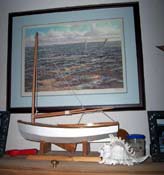 |
Here is
the model - a shrine to my Bobcat
(click
images to enlarge) |
|
I read the book, sort of. Okay, I mostly ogled the
pictures. I decided that I could build this boat and
announced this to my wife. “Finish the house
first” was again her response. I complied but
only because at that point I didn’t have a place
to build a boat. I eventually got the house done,
well done enough that we could live in it. My friends
all say that I have the best wife in the world for
putting up with me when they hear that my wife has
been cooking on a two burner electric hot plate for
thirteen years. I just tell them that you gotta be
choosy when wife shopping. Beautiful; laughs at my
corny jokes; and puts up with my stupid ideas were
the top three things on my list when I was wife shopping.
| I'll be danged
that worked!! |
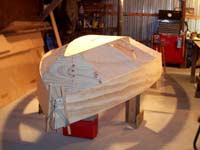
|
|
About ten years passed by, and I got caught up with
other projects, career, running a business, going
out of business, children, financial woes… etc,
etc. When one day in October 2004 I had just finished
pouring a slab in my little shack of a shed and shazam,
I had a workshop!!!! The first thing that crossed
my mind as I walked across the freshly poured, almost
dry concrete was, “I can build a boat now”.
My wife didn’t even say to finish the house
when I mentioned it to her. I went to my bookshelf,
found my “Build the Instant Catboat” book,
blew off the dust and started to ACTUALLY read it.
In December of that year I built a scale model of
the boat to the actual plan specs and not the way
Payson recommends in the book. It turned out so good
that most people guessed it was a boat the first time!!!
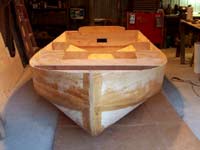 |
Taping,
Taping, Taping that's all I ever do!!!
|
|
In January I started looking for wood. Ouch!!! I
had been planning to use Marine grade plywood, but
I wasn’t sufficiently over the aforementioned
financial woes and going out of business to afford
that. I recalled that Payson said that exterior grade
plywood used the same glue as Marine. I thought long
and hard and finally realized that this was actually
a no brainer, at least for me right now. The price
of marine grade plywood was a deal breaker at this
point in the game. I started looking at exterior grade
wood and finally ran across a really nice looking
fir at the local lumber yard. I bought ten sheets,
went home and started plotting dots on them, which
eventually became lines that would hopefully closely
resemble the parts of a boat when cut out. I tried
to not think about or hope too hard that the pieces
would all match up properly when assembled for fear
of jinxing myself.
It crossed my mind early on that I could be spending
a lot of time cutting out pieces of wood that would
never fit together. You see, even though I had built
a house, with a house you can measure a straight line
and determine that you need a board cut to such and
such length to fit. Then you can cut it out, measure
it again and say “Yeah, that’s close enough”.
With a boat you are dealing with all of these fancy
curves and have no way, that I am aware of, to determine
if that shape resembles the desired shape until you
bring them all together and attempt to assemble. I
was afraid that I would make a simple mistake in calculating
these “dots” on the sheet and ruin a whole
bunch of wood. The only thing I knew to do was suck
it up and keep on cutting.
| What??? through
taping?? YAY!!!!! |
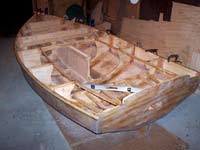
|
|
In March of 2005 I finally had all the pieces cut
out, well enough to make a hull I hoped. On a Saturday
morning I went out to my little shack/shed and began
dragging the pieces I needed to the center of the
shed. I quickly threw together some scrap wood for
the stands and began converting the pile in to a reasonable
facsimile of a boat. I was impressed at how the Spanish
windlass actually worked to bring the bow together
and spread the hull at the beam (wonders never cease).
Now came the dreaded bilge panels……..
gasp……. will they actually fit? Can I
get them bent into place? By this time, I had read
in some forums that this boat was as close to torturing
plywood as one could get without fear of jail time.
I began placing the first piece in at the transom
and slowly worked my way forward. I tried Payson's
idea of using a saw to remove excess wood and get
the seams to close, but I found that the belt sander
worked better for me. When I got the curve of the
panel that brings it to the stem at the bow I began
to understand the part about torturing plywood. The
only exception to that concept was that I felt like
it was torturing me more! I used a wet cloth and worked
the panel over and finally got it to meet the stem,
then set the screws quickly. I think it took me all
day Saturday to get the bulkheads, transom, bottom
and two side panels assembled. The next weekend it
took all day Saturday to get one bilge panel on and
then all day Sunday to get the other, but I now had
a closed in hull. Guess what? All the panels fit within
a sixteenth of an inch! I was amazed…. maybe
a little shocked even.
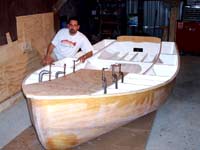 |
Yeah...
I built it.
|
|
A friend came by and looked at my progress, he oohed
and ahhed at my handiwork, but later admitted that
when he left he was thinking what a shame that I was
wasting all that perfectly good plywood to be burned
in pile behind the shed someday when I gave up on
the project.
I hesitate to discuss the next step - TAPING THE
SEAMS………. aaarghhhh!!!!! This is
plain and simple TORTURE for the boat builder. It
reminds me of taping and floating sheet-rock. You
work and work and work, then you step back to admire
your work. Sure enough you worked for hours and it
looks the same. I thought I was never going to get
through with this stage and what a mess I made. Resin
dripped all over the place like a kindergartener’s
art class. You can bet that was fun to clean up. Looking
at my project one afternoon I was convinced it would
never be anything more than an ugly duckling. One
that only it’s mother (or father????) could
love.
| Getting closer....
hey this ain't no stinking electric boat! |
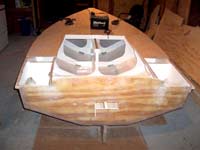
|
|
After what seemed like ten or fifteen years of hard,
tedious, and painful labor I got most of the @#$&@$#@&*!!!
seams taped! (Sorry for that burst of vulgarity, but
the memories flooding my mind took over the keyboard.)
Around this time I was beginning to think of how to
finish out the boat. When I built my model I had merely
varnished the deck. I really wanted this beautiful
wooden boat look for my REAL boat. I also wanted to
stick to the plans which called for glassing over
the hull and deck. I began to peruse the various different
forums and inquire about using a stain under a polyester
resin to achieve a rich wood appearance. Boy…..
let’s skip that painful memory. I did however
run into another discussion about exterior plywood.
Someone pointed out that before you started construction
with anything less than marine grade you should do
a boil test. YIKES….. that rang a bell. Payson
had said the same thing. Did I remember to do that???
Of course not. I began to panic, some of the descriptions
seemed to resemble the plywood I was using. Delaminating
plywood, warped, and checking panels filled my dreams
that night. Before I went to work the next day I went
out to the shed and retrieved a couple scraps, I took
them into the house and asked my faithful and wonderful
wife to boil them for three hours. The look on her
face was priceless, she was convinced that I had finely
gone over the edge. After a bit of explaining she
agreed to do it, I told her I would call in three
hours for the results. The wood passed with flying
colors and my breathing returned to normal.
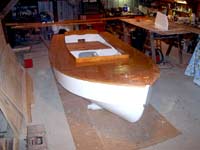 |
Ohh..
Baby you are looking good.... (kiss)...
good morning!!
|
|
I stopped construction in about April of 2005 due
to beginning a new job, my schedule was a mess. I
was now doing shift work and it took a while for my
body and brain to become synchronized again. In the
fall of that year I began a training program at work
that had me home every day at 3:30 pm. I began to
make use of that time on my boat.
Construction after the SEAM TAPING went pretty smoothly.
It became quite pleasant in fact. Every day when I
got home I would go out to the shed and work for two
or three hours, it was my new way of relaxing. Progress
began to show on the boat. I decided to not stain
the deck, to just glass it and if it looked okay to
varnish the fiberglassed deck and not to paint it.
The hull I painted with Ace brand, solvent based,
porch and deck paint. The samples I had tried finished
out real nice and turned VERY hard after a fairly
long cure time of a few weeks, (surely if you have
read this far you don’t expect me to be more
precise than that). Of course the paint would not
go on as smoothly on the boat as it did on the test
piece…..oh no….no way. It went on very
nicely, laid down real nice with no brush strokes
whatsoever and then sagged like a sixty year old stripper……
yeow…… ugly mental image, but you get
the idea. I had to sand and scrape almost all of that
coat off and start over. Fifteen (maybe fewer) coats
later I decided that it was good enough (I was tired
of painting) and went to work on the deck.
| My Bobcat
parked in front house that so dang long
to build. |
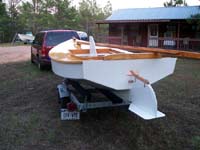
|
|
The deck after fiberglassing looked good enough and
I decided to use a plain spar varnish on it. I had
considered using a stain and varnish first but it
wasn’t necessary. The wood had taken on a nice
glow with just the addition of the polyester resin.
In February of 2006 I read on this website about
the Gulf Coast Messabout at Magnolia Beach. I decided
then and there that I would finish my boat and launch
there for the first time. Magnolia Beach is where
my family have been going to do most of our sailing
and fishing for years. I was quite surprised to realize
that all of ya’ll knew about the place as well.
This is a small boat sailors heaven. I busted my tail
on the boat from then right up until the three days
before the Messabout to have her ready for the event.
We made it, and that story will be in PART
2 (coming next month).
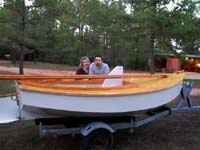 |
Me with
my beautiful wife that puts up with me.
|
|
|